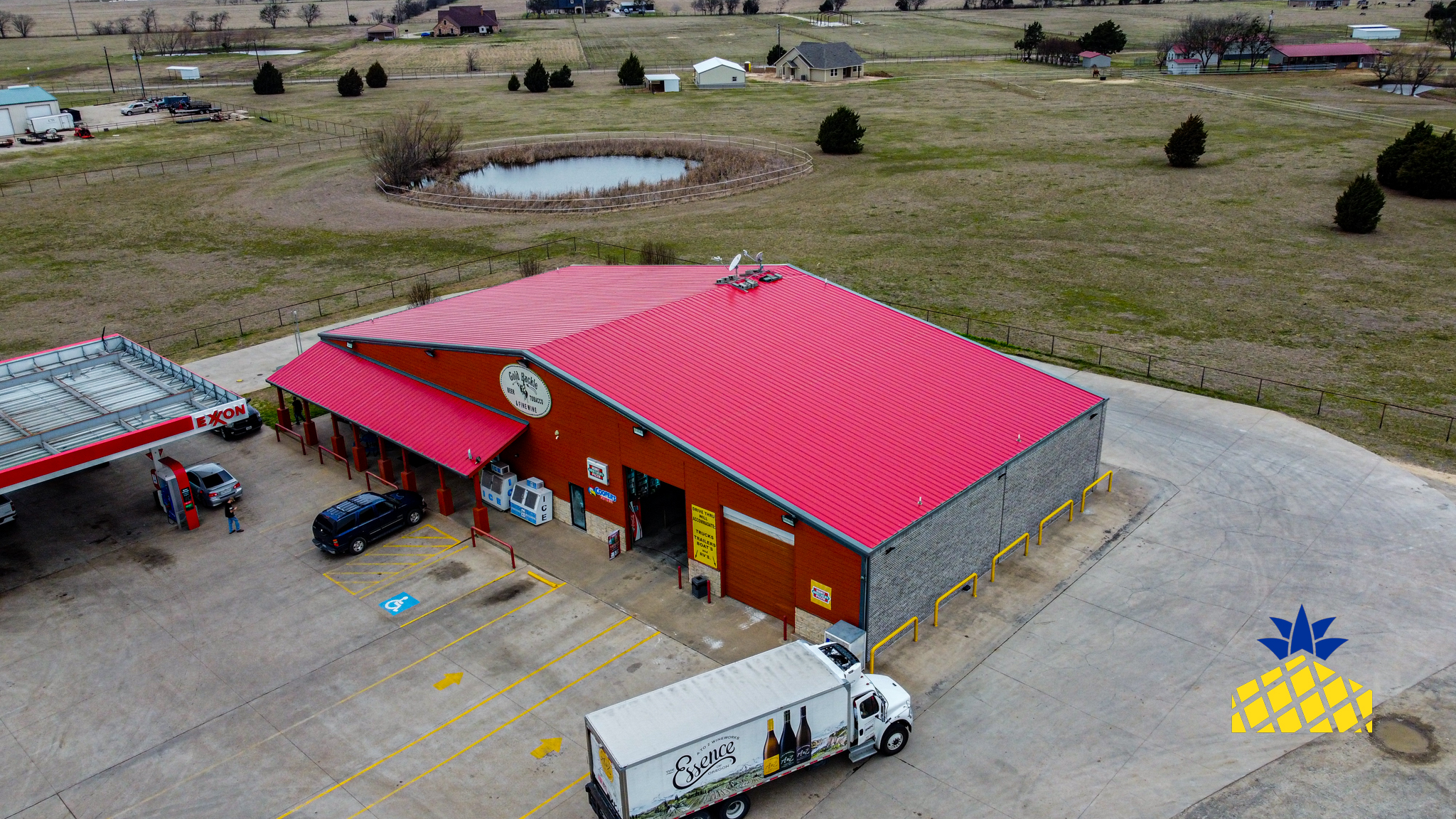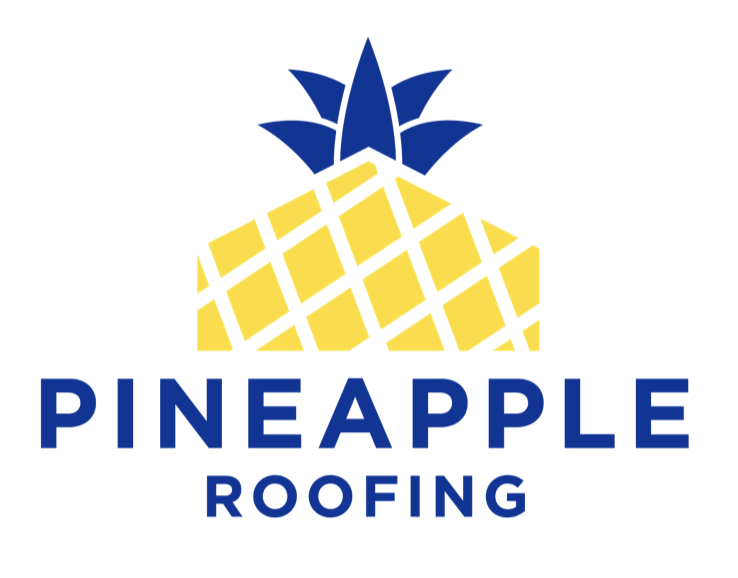
When considering a roofing system that offers exceptional resilience, refined aesthetics, and long-term value, few choices compare to standing seam metal roofing. In Texas, where hail, high winds, and extreme heat are frequent challenges, this style has emerged as a top option for both homeowners and business property owners. As a full-service roofing company offering both commercial roofing and residential roofing services, Pineapple Roofing has seen the advantages of standing seam systems firsthand.
In this guide, we’ll explore how standing seam metal roofing works, the advantages and trade-offs, how it stacks up against other roofing types, and why it may be the right investment for your next roof repair or roof replacement.
What Is Standing Seam Metal Roofing?
A standing seam metal roof is made of vertical panels that extend uninterrupted from the peak of a roof down to its eaves. These panels are joined side-by-side using raised, interlocking seams that ride above the surface of the roof — thus giving the system its name. The raised seams not only enhance structural integrity but also protect the fasteners from being directly exposed to the elements.
Unlike traditional corrugated metal roofs where screws are visible, in standing seam systems the fasteners are concealed beneath the seams, helping to reduce leak risk and potential corrosion.
Why This Roofing System Is Well-Suited for Texas Weather
The diverse and often extreme weather found throughout the Dallas-Fort Worth region puts any roof to the test. From intense summer heat to hailstorms and gusty winds, your roof must be built for durability. Standing seam metal roofing delivers a blend of high performance, long lifetime, and modern curb appeal making it an increasingly popular alternative to traditional asphalt shingle roofs. For homeowners and business owners wanting something more robust and long-lasting, this type of metal roof is worth serious consideration.
Major Benefits of Standing Seam Metal Roofing
Exceptional Longevity
Standing seam roofs are built for the long haul with the typical lifespan of 40 to 70 years, far exceeding what most asphalt shingles deliver in Texas conditions. Concealed fasteners mean fewer weak points and less exposure to weather wear. Given the hail-prone environment of many Texas neighborhoods, this kind of durability is especially beneficial.
High Resistance to Weather Elements
In high-wind conditions, traditional shingles can lift or blow off entirely. Standing seam metal panels are anchored securely and interlocking seams form a tight barrier against wind-driven rain. In addition, metal roofing is non-combustible and often earns a Class A fire rating, the highest available, which provides valuable peace of mind in dry Texas summers.
Energy Efficiency
Metal reflects a significant portion of solar heat, reducing the amount of heat transferred into your building and lowering cooling costs during long Texas summers. Many standing seam systems also offer reflective coatings, boosting energy savings further. Over time, the savings on monthly utility bills can make a meaningful difference and lower total cost of ownership.
Clean, Modern Aesthetics
Standing seam metal roofs offer sleek, clean lines and a sophisticated look that elevates both residential and commercial properties. With a wide range of colors and finishes available, this roofing style fits modern farmhouse homes, contemporary office buildings, and everything in between - enhancing curb appeal and perceived value.
Lower Maintenance Requirements
Because fasteners are hidden and seams are elevated, standing seam systems tend to require less upkeep than exposed-fastener metal or typical shingle roofs. Homeowners usually need only periodic inspections and basic cleaning to keep the system performing at peak levels for decades.
Trade-Offs and Considerations
Higher Up-Front Cost
Compared with standard asphalt shingles, standing seam systems come with a higher initial investment. However, given their extended lifespan, reduced maintenance burden, and energy savings, many property owners view it as a long-term value decision.
Installation Requires Expertise
Not all roofing contractors are trained or equipped to install standing seam metal correctly. Specialized tools and techniques are required for panel fabrication, seaming and fastening. A sub-par installation can undermine many of the benefits, so selecting an experienced roofing company is critical.
Perceptions Around Weather Noise
Some homeowners worry that metal roofs are noisy during rain or hail. In well-designed installs with proper underlayment and insulation, the sound levels are comparable to, or even quieter than, asphalt shingles. Given the frequent storms seen in Texas, ensuring the roofer uses best practices is especially important.
How Standing Seam Compares with Other Roof Types
Standing Seam vs. Asphalt Shingles
While asphalt shingles are typically more affordable upfront, their performance in Texas is often limited to 15-20 years before needing replacement under severe conditions. A standing seam metal roof offers two to three times that lifespan, stronger resistance to storm damage, and lower maintenance - making metal the better long-term value.
Standing Seam vs. Exposed-Fastener Metal Panels
Exposed-fastener metal panels (sometimes called “R-panels”) are less costly and easier to install, but the visible screws may loosen over time and require ongoing maintenance. Standing seam systems hide fasteners entirely, eliminating that weak point and delivering a longer life & more refined look.
Standing Seam vs. Tile Roofing
Clay or concrete tile is sometimes popular in Texas for its appearance, but tile is heavy and requires more structural support, so it can be more brittle under hail impact. Standing seam metal achieves comparable or superior longevity and durability with less load on the structure.
Why Roof Pitch Matters for Standing Seam Installations
Standing seam metal roofing performs best on moderate to steep roof slopes. While it can be adapted for low-slope applications, the design must ensure adequate drainage and help avoid ponding or leaks. This is especially important in Texas where heavy downpours are common. A qualified roofing contractor will assess your structure’s pitch and determine suitability.
Step-by-Step: The Installation Process
1. Initial Inspection & Planning
The process begins with a thorough evaluation of the existing roof structure. Precise measurements are taken and panels are custom-fabricated for your specific roof. Customization helps minimize waste and ensures a precise fit, rather than relying on off-the-shelf panels.
2. Removing the Existing Roof
Many installations require stripping the old materials down to the roof deck. This step allows the contractor to check for hidden damage (rot, soft spots, structural issues) which must be remedied before the new system is installed.
3. Installing Underlayment
A high-quality underlayment is laid down to add a secondary moisture barrier. In Texas, where hail, heavy rain and extreme thermal shifts are common, a premium synthetic or high-temp rated underlayment often makes the most sense.
4. Installing the Metal Panels
Custom vertical panels are installed from ridge to eave, with raised seams interlocked and secured using concealed fasteners and specialized tools to crimp the seams. Flashing is installed at edges, valleys and around roof penetrations (vents, chimneys, skylights) to ensure a complete water-tight system.
5. Final Inspection & Clean-Up
Once installation is complete, the project is inspected to ensure every seam is secure, flashing is correctly sealed and installation meets manufacturer and quality standards. A reputable roofing company will also provide photo documentation so you can see exactly how your roof was built.
Maintenance Advice for Standing Seam Roofs
Although standing seam metal roofs require far less routine service than many roof types, some proactive care helps preserve their performance. Schedule an inspection annually (especially after major storms) to check for debris build-up, compromised flashing, or any panel damage. Keeping gutters clean, trimming nearby trees, and ensuring proper attic ventilation will further extend the life of your roof. If any repair is needed, always use a contractor with metal-roofing experience to preserve the integrity of the seams and fasteners.
Cost Considerations for Texas Homeowners and Business Owners
In Texas, the cost of standing seam metal roofing depends on roof size, slope, complexity, and material choice. On average, expect to invest two to three times more than an asphalt shingle roof initially. That said, the longer lifespan, low maintenance, energy savings and increased property value often justify the premium. Many homeowners and investors appreciate that a standing seam roof is seen as a “premium feature” by buyers and can boost resale value.
How Insurance Can Work in Your Favor
Because standing seam metal roofing is so robust, many insurance companies view it as a lower risk than traditional shingle roofs. That may translate into lower premiums or a more favorable claims history after hail or wind damage. For property owners in storm prone areas, choosing a durable system like standing seam is a smart risk-management move. Making sure your roofing contractor provides full documentation of the new roof helps with insurance credibility.
Why Choose Pineapple Roofing for Your Standing Seam Metal Roof
At Pineapple Roofing, we specialize in both residential roofing and commercial roofing throughout the DFW area, and we bring the certifications and attention to detail needed for standing seam metal roof systems. From project planning to installation to final inspection, our team ensures the highest standards of workmanship, quality materials, and communication every step of the way. We provide manufacturer-backed warranties, clean job sites, and professional documentation so you can trust your investment is protected.
For Texas property owners looking for a long-term, high-performance roof, standing seam metal roofing stands out from almost all other options. With superior durability, storm and fire resistance, improved energy efficiency and sleek visual appeal, it delivers an exceptional return in terms of protection and value. While the upfront cost is higher, the savings in maintenance, energy and replacement cycles make it a smart choice for both homeowners and commercial clients.
If you’re evaluating a roof repair or roof replacement in the DFW region, Pineapple Roofing is ready to provide expert guidance, free assessments and top-tier standing seam installation services. Let’s talk about how this premium roofing system can elevate your property.

